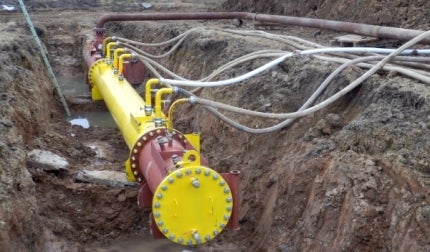
Hydrostatic retesting of existing pipelines allows revalidation and upgrading and verifying the pipeline strength needed for its future safe and reliable operation at the specified MAOP.
CEPS provides:
- Mechanical and metallographic testing of steel samples taken from the pipeline
- Hydrostatic testing, cyclic pressure load tests, burst tests on test vessels manufactured from pipe spools taken from the pipeline to verify that target operating pressure level complies with the required MAOP and to simulate a desired future pipeline lifetime
- Safe and reliable implementation of the testing programme on the pipeline
- Engineering studies based on the existing pipeline data, the pipeline material examination and experimental work on test vessels
- Pipeline upgrading project management to increase the MAOP above its originally specified level
- Pipeline rehabilitation project management
During hydrostatic tests of many old pipelines, it is possible to achieve test pressures loading the pipeline steel to the level of yield stress without consuming the elasticity of the steel. Such tests accurately determine the actual pipeline state, critical defects burst and are repaired, subcritical fatigue cracks are blocked (CRACK BLUNTING), stress concentrators removed, and areas with reduced WT like general corrosion spots re-shaped that results in better resistance to fatigue process. The achieved cost saving on such projects is enormous.
Our equipment
- Pressure heads: 12in to 48in, 150-250 bar
- High-pressure pumps: max 400l/min, max 250 bar; max 220l/min, max 250 bar; max 100l/min, max 170 bar, 200bar
- Filling pumps: 130m³/hr, max 35 bar; 185m³/hr, max 40 bar; 350m³/hr, max 60 bar
- Filling/feeding pump: 120m³/hr, max 14bar
- Mobile tanks: 10m³- 30m³
- Control and measurement rooms: mobile on truck
- Computerised control units
- Pressure transmitters: 350 bar, accuracy 0.075%
- Flow meters: 470l/min, accuracy 0.2%
- Thermometer: −30°C to +60°C, accuracy 0.05°C
- Compressors: 1,700m³/hr, 20 bar; 1,500m³/hr, 12 bar; 600m³/hr, 12 bar; 900m³/hr, 25 bar (inlet 10 bar)
- Boosters
- Air dying units: 3,600m³/hr, -80°C, 8 bar; 650m³/hr, -70°C, 8 bar
- Vacuum pumps: 200m³/hr, 0,05 mbar
CEPS main references
- Rehabilitation of more than 750 km of old 4in to 28in natural gas pipelines with the MAOP increasing from 16 bar to 40 bar or from 25 bar to 40 bar in Czech Republic
- Upgrade of 35 km of existing 16in natural gas pipeline from 25bar to 55 bar for PGNIG Poland
- Upgrade of 55km of existing strategic 16in natural gas pipeline from 25bar to 73 bar for Gaz-System, Poland
- Revalidation of 8km section of 28in high-pressure pipeline in Latvia after a long period of shut down








